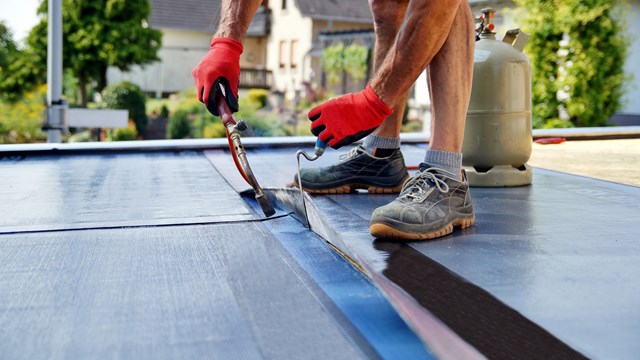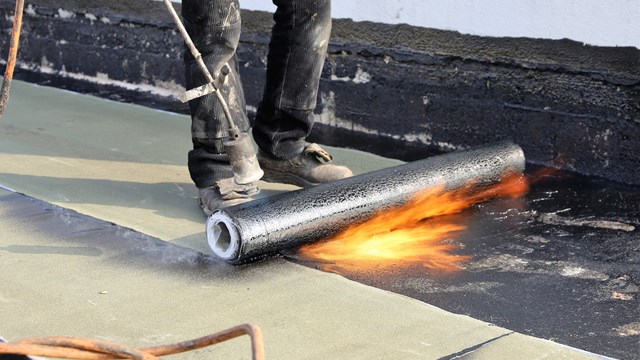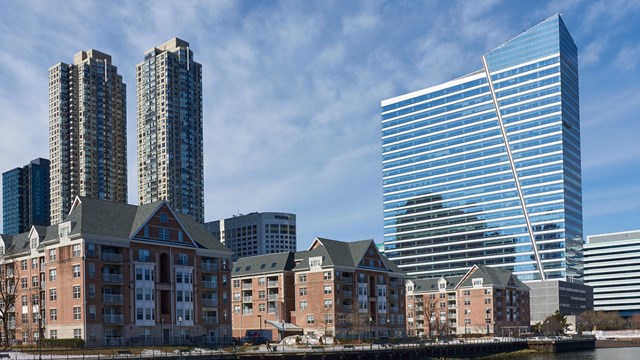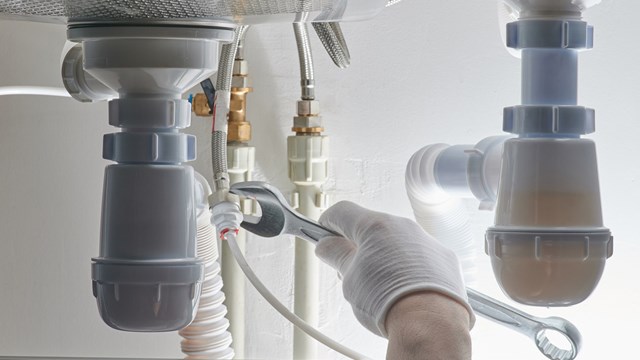
As we go about our busy lives, we often forget about everyday physical facts—like the unceasing tension gravity places on the materials we assemble into buildings and other structures, for example. Whether or not we are paying attention, all of matter is reacting to gravity’s pull, and those forces can result in small tears or holes in facades, roofs and other parts of a building.
Over time, such stresses can result in a hole in a roof, oftentimes at a plane change area, such as where flashing surrounds a skylight or a chimney. Even if it’s just a pinhole leak to start, if it is left undetected for very long, that dripping water can cause serious damage to a building and even adversely affect its structural integrity.
Water leaks are the bane of many homeowners and many condominium building engineers or superintendents. But unlike a drippy faucet or a drafty window, which often can be simply fixed, water leaks sometimes can be very difficult to find and remedy. Many different technologies exist to help find the source and the extent of leaks and other technologies can help minimize the damage these leaks cause. Knowing what makes leaks happen, the ways that they are found, and how they’re repaired is essential for anyone living in a multifamily building. Because after all, such a leak might happen in nearly anyone’s unit and still affect everyone in the condo because of a costly fix that all will have to pay for.
Spotting Problems
A longstanding leak might signal the need for a major building improvement project, but it might also require a less invasive solution, such as a spot replacement of just part of a roof. Knowing what solution to use is the contractor’s bailiwick, but understanding something about the fixes for water leaks, and the best practices for finding the source of the leaks, is the responsibility of each building resident.
Water leaks in a condo building are generally of two kinds: rain-related or plumbing-related. “Rain related leaks are typically concurrent with weather events,” says William J. Pyznar, P.E., a principal with Falcon Engineering in Bridgewater. “Plumbing related leaks are often consistent or related to the use of the failing plumbing component.”
“A plumbing-related leak is going to occur in the interior of the building as opposed to the exterior,” adds Jim Murphy, owner of Pro-Tec Building Restoration Services in East Hanover. “If you get a leak in the middle of your room and you know it’s not the roof and it’s too far away from the windows, more than likely it will be a plumbing-related leak. Plumbing-related leaks could be caused from a lack of insulation on the pipes and there’s condensation. Lots of times there is a temperature differential between the cold water passing through the pipes and a hot room that will cause condensation on the pipe, it’ll cause the pipes to sweat.”
“The brick pointing is a common point of origin for water leaks,” says Joseph DelGuidice, project manager for World Wide Construction and Restoration in Ridgefield Park. “The cement between the brick gets deteriorated and water gets in that way.”
A leak doesn’t always have to be particularly severe before residents notice water stains or seepage in the walls or ceiling, and some leaks will show up more or less immediately. Other leaks could be happening for weeks before anyone notices. Some leaks might not be evident in any way, such as a pipe leak for which the building’s management can’t find the source. Such a leak might initially be detected through the water meter of a condo’s HVAC system.
At that point, a building’s management team should have experts bring in monitoring equipment to find the leak.
These days, infrared or “thermal” imaging often is used to find a leak’s source. Since a leak in a multifamily building can come from different spots on a large surface such as the building’s exterior, thermal imaging covers all of that territory by looking for a temperature signature on the surface that indicates where the leak is located. The technology helps a professional to find areas of the building that are water-damaged. When used on a roof, a thermal imaging device scans the surface horizontally, detecting where moisture is trapped within the roof.
“Let’s say you have a 30 story high-rise in Fort Lee and everything looks the same from the outside of the building—one way to find out where the leak is coming from is to do a water filtration test or a flood test,” says Murphy. “You’re basically simulating a wind-driven rain using spray bars and hoses. We typically start at the bottom of the windows and work our way up.”
Surveying the Situation
Another fairly routine way of inspecting a building to find water leaks is doing a roof survey. In a roof survey, the condo building’s management will call in a professional, who will do a thermal imaging survey of the entire roof. He or she will also take photos of the roof and then mark with paint any damaged area of the roof. Generally, a professional will offer spot fixes of the roof when small parts of it are damaged or leaking.
“If a large portion of the roof and the underlying materials have become wet, it is almost always better to replace the roof,” says Pyznar.
“Fixing a roof leak or replacing the roof usually comes down to budgets and how severe the problem is,” adds Murphy. “Obviously you’ll try to fix the leak but if it gets to a point where everything is bad you have to replace it. That decision is usually made by the condo owners or the building manager.”
The single most effective preventative step to take to avoid roof leaks is proper gutter and downspout maintenance. Make sure these parts of the building are always clear and free of obstructions, by regularly cleaning them.
One method of detecting leaks in a roof sort of imitates what happens when a gutter or downspout is clogged—it backs up water onto one part of the roof. By creating a dam made of sheet metal around an area of a flat roof surface and then applying water to that area where the leak was, specialists can trace a leak to see where the water is coming into the building.
Some companies, like American Leak Detection, stick strictly to the inspection side of this business. The company finds water leaks non-invasively—without excavation or demolition. For exterior water penetration issues, American Leak Detection uses thermal imaging technology and also electric vector mapping, which employs an electric current and water to find even a pinhole-sized tear.
Whether or not an owner hears a drip coming from the roof or elsewhere, such a leak might be making a sound that still is detectable. Specialists sometimes use ultra sound technology to hear and find an active leak of water or steam. This technology isn’t used on roofs, for obvious reasons—it’s too loud outside for the technology to work.
Repairing Leaks
The most common source of water leaks in suburban multifamily buildings is the roof. Areas of the roof where flashing is used typically are the weakest points on the roof surface, and are the spots most likely to develop a leak. Because each leak is unique, there’s no rule of thumb for how long it can take to find a water leak. Finding the source of the problem might take just a couple of hours, or it might require many hours of work, depending upon the size of the property.
Costs for bringing in a leak detection specialist vary. Several different types of professionals are qualified to do the job, including firms that refer to themselves as leak detection specialists, as well as engineers or contractors with expertise in the area. Hiring such professionals can start at $600 per man per day, and often two men are needed to inspect for a leak problem. Some day rates range upwards of $2,000.
Knowing how to pick the right company to handle the job is a matter of matching up skills and needs. For a whole building leak problem, management always should consult the building’s engineer regarding how to proceed. If they pay attention, though, building owners and management will be able to pick out the best firms to do the work, based in part upon what they say.
When they are found, leaks are repaired in various ways. The type of fix for a leak always is dependent upon the type of problem, but conditions of the building material that is affected, the age of the building component (such as a roof, stone façade, or even steel window lintils), and the size and scope of the leak all factor into a remedy. The amount of damage caused by the leak also is part of the equation.
Determining whether the fix of the roof leak worked can be done with another low-tech water test. The expert simply floods the area of the roof that’s been repaired to see if it leaks. This is a common part of Murphy’s job. “We do lots of water infiltration tests,” he says. “It’s one of the best ways to detect a leak.”
Other basement leak fixes could be much more invasive. Some buildings have basement water problems because their exterior brick walls are porous due to moisture coming through them. In these scenarios, the water is coming through because the brick is in contact with a water source leaching from the soil. So, a contractor must excavate to the base of the building to get to the root of the problem. This fix involves moving soil and landscaping, and the logistics can get pretty complicated.
Not every contractor will give an ironclad guarantee on his work, but many are passionate about their jobs, and dedicated to helping their clients. These are the specialists that a building’s management should be working to find, because they will do the job right.
Jonathan Barnes is a Pittsburgh freelance writer and regular contributor to The New Jersey Cooperator. Staff Writer Christy Smith-Sloman contributed to this article.









Leave a Comment